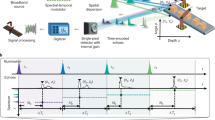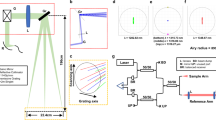Abstract
The ability to determine absolute distance to an object is one of the most basic measurements of remote sensing. High-precision ranging has important applications in both large-scale manufacturing and in future tight formation-flying satellite missions, where rapid and precise measurements of absolute distance are critical for maintaining the relative pointing and position of the individual satellites. Using two coherent broadband fibre-laser frequency comb sources, we demonstrate a coherent laser ranging system that combines the advantages of time-of-flight and interferometric approaches to provide absolute distance measurements, simultaneously from multiple reflectors, and at low power. The pulse time-of-flight yields a precision of 3 µm with an ambiguity range of 1.5 m in 200 µs. Through the optical carrier phase, the precision is improved to better than 5 nm at 60 ms, and through the radio-frequency phase the ambiguity range is extended to 30 km, potentially providing 2 parts in 1013 ranging at long distances.
This is a preview of subscription content, access via your institution
Access options
Subscribe to this journal
Receive 12 print issues and online access
$209.00 per year
only $17.42 per issue
Buy this article
- Purchase on Springer Link
- Instant access to full article PDF
Prices may be subject to local taxes which are calculated during checkout





Similar content being viewed by others
References
Cash, W., Shipley, A., Osterman, S. & Joy, M. Laboratory detection of X-ray fringes with a grazing-incidence interferometer. Nature 407, 160–162 (2000).
White, N. X-ray astronomy—Imaging black holes. Nature 407, 146–147 (2000).
Gendreau, K. C., Cash, W. C., Shipley, A. F. & White, N. MAXIM Pathfinder X-ray interferometry mission. Proc. SPIE—Int. Soc. Opt. Eng. 4851, 353–364 (2003).
ESA. XEUS: X-ray evolving-universe spectroscopy. ESA CDF Study Report CDF-31(A), 1–237 (2004).
Fridlund, M. Future space missions to search for terrestrial planets. Space Sci. Rev. 135, 355–369 (2008).
Fridlund, C. V. M. Darwin-the infrared space interferometry mission. ESA Bulletin 103, <http://www.esa.int/esapub/bulletin/bullet103/fridlund103.pdf> 20–25 (2000).
Lawson, P. R. & Dooley, J. A. Technology plan for the terrestrial planet finder interferometer. Publ. Jet Propulsion Laboratory 05–5, 1–149 (2005).
Coroller, H. L., Dejonghe, J., Arpesella, C., Vernet, D. & Labeyrie, A. Tests with a Carlina-type hypertelescope prototype. Astron. Astrophys. 426, 721–728 (2004).
Lemmerman, L. et al. Earth science vision: platform technology challenges. Scanning the present and resolving the future. Proc. IEEE 2001 International Geoscience and Remote Sensing Symposium (2001).
Turyshev, S. G. & Shao, M. Laser astrometric test of relativity: Science, technology and mission design. Int. J. Mod. Phys. D 16, 2191–2203 (2007).
Turyshev, S. G., Lane, B., Shao, M. & Girerd, A. A search for new physics with the BEACON mission. Preprint at <http://arxiv:0805.4033v1> (2008).
Estler, W. T., Edmundson, K. L., Peggs, G. N. & Parker, D. H. Large-scale metrology—an update. CIRP Ann. Manuf. Technol. 51, 587–609 (2002).
Bobroff, N. Recent advances in displacement measuring interferometry. Meas. Sci. Technol. 4, 907–926 (1993).
Nagano, S. et al. Displacement measuring technique for satellite-to-satellite laser interferometer to determine Earth's gravity field. Meas. Sci. Technol. 15, 2406–2411 (2004).
Pierce, R., Leitch, J., Stephens, M., Bender, P. & Nerem, R. Inter-satellite range monitoring using optical inteferometry. Appl. Opt. 47, 5007–5019 (2008).
Beck, S. M. et al. Synthetic aperture imaging LADAR: laboratory demonstration and signal processing. Appl. Opt. 44, 7621–7629 (2005).
Lucke, R. L., Richard, L. J., Bashkansky, M., Reintjes, J. & Funk, E. E. Synthetic aperture ladar. Naval Research Laboratory, FR 7218–02-10,051 1–28 (2002).
Minoshima, K. & Matsumoto, H. High-accuracy measurement of 240-m distance in an optical tunnel by use of a compact femtosecond laser. Appl. Opt. 39, 5512–5517 (2000).
Dandliker, R., Thalmann, R. & Prongue, D. Two-wavelength laser interferometry using superheterodyne detection. Opt. Lett. 13, 339–341 (1988).
Williams, C. C. & Wickramasinghe, H. K. Absolute optical ranging with 200-nm resolution. Opt. Lett. 14, 542–544 (1989).
Stone, J. A., Stejskal, A. & Howard, L. Absolute interferometry with a 670-nm external cavity diode laser. Appl. Opt. 38, 5981–5994 (1999).
Yang, H. J., Deibel, J., Nyberg, S. & Riles, K. High-precision absolute distance and vibration measurement with frequency scanned interferometry. Appl. Opt. 44, 3937–3944 (2005).
Schuhler, N., Salvade, Y., Leveque, S., Dandliker, R. & Holzwarth, R. Frequency-comb-referenced two-wavelength source for absolute distance measurement. Opt. Lett. 31, 3101–3103 (2006).
Salvade, Y., Schuhler, N., Leveque, S. & Le Floch, S. High-accuracy absolute distance measurement using frequency comb referenced multiwavelength source. Appl. Opt. 47, 2715–2720 (2008).
Jin, J., Kim, Y.-J., Kim, Y. & Kim, S.-W. Absolute length calibration of gauge blocks using optical comb of a femtosecond pulse laser. Opt. Express 14, 5968–5974 (2006).
Fox, R. W., Washburn, B. R., Newbury, N. R. & Hollberg, L. Wavelength references for interferometry in air. Appl. Opt. 44, 7793–7801 (2005).
Lay, O. P. et al. MSTAR: a submicrometer, absolute metrology system. Opt. Lett. 28, 890–892 (2003).
Hänsch, T. W. Nobel Lecture: Passion for precision. Rev. Mod. Phys. 78, 1297–1309 (2006).
Hall, J. L. Nobel Lecture: Defining and measuring optical frequencies. Rev. Mod. Phys. 78, 1279–1295 (2006).
Ye, J. Absolute measurement of long, arbitrary distance to less than an optical fringe. Opt. Lett. 29, 1153–1155 (2004).
Joo, K.-N. & Kim, S.-W. Absolute distance measurement by dispersive interferometry using a femotsecond pulse laser. Opt. Express 14, 5954–5960 (2006).
Swann, W. C. & Newbury, N. R. Frequency-resolved coherent lidar using a femtosecond fiber laser. Opt. Lett. 31, 826–828 (2006).
Joo, K. N., Kim, Y. & Kim, S. W. Distance measurements by combined method based on a femtosecond pulse laser. Opt. Express 16, 19799–19806 (2008).
Newbury, N. R., Swann, W. C. & Coddington, I. Lidar with femtosecond fiber-laser frequency combs. 14th Coherent Laser Radar Conference (Snowmass, Colorado, 2007).
Keilmann, F., Gohle, C. & Holzwarth, R. Time-domain and mid-infrared frequency-comb spectrometer. Opt. Lett. 29, 1542–1544 (2004).
Schiller, S. Spectrometry with frequency combs. Opt. Lett. 27, 766–768 (2002).
Yasui, T., Kabetani, Y., Saneyoshi, E., Yokoyama, S. & Araki, T. Terahertz frequency comb by multifrequency-heterodyning photoconductive detection for high-accuracy, high-resolution terahertz spectroscopy. Appl. Phys. Lett. 88, 241104 (2006).
Coddington, I., Swann, W. C. & Newbury, N. R. Coherent multiheterodyne spectroscopy using stabilized optical frequency combs. Phys. Rev. Lett. 100, 013902 (2008).
Schlatter, A., Zeller, S. C., Pashcotta, R. & Keller, U. Simultaneous measurement of the phase noise on all optical modes of a mode-locked laser. Appl. Phys. B 88, 385–391 (2007).
Giaccari, P., Deschenes, J.-D., Saucier, P., Genest, J. & Tremblay, P. Active Fourier-transform spectroscopy combining the direct RF beating of two fiber-based mode-locked lasers with a novel referencing method. Opt. Express 16, 4347–4365 (2008).
Dorrer, C., Kilper, D. C., Stuart, H. R., Raybon, G. & Raymer, M. G. Linear optical sampling. IEEE Photon. Technol. Lett. 15, 1746–1748 (2003).
Dorrer, C. High-speed measurements for optical telecommunication systems. IEEE J. Quantum Electron. 12, 843–858 (2006).
Ciddor, P. E. & Hill, R. J. Refractive index of air. 2. Group index. Appl. Opt. 38, 1663–1667 (1999).
Telle, H. R., Lipphardt, B. & Stenger, J. Kerr-lens, mode-locked lasers as transfer oscillators for optical frequency measurements. Appl. Phys. B 74, 1–6 (2002).
Stenger, J., Schnatz, H., Tamm, C. & Telle, H. R. Ultraprecise measurement of optical frequency ratios. Phys. Rev. Lett. 88, 073601 (2002).
Newbury, N. R. & Swann, W. C. Low-noise fiber laser frequency combs. J. Opt. Soc. Am. B 24, 1756–1770 (2007).
Rosenband, T. et al. Frequency ratio of Al+ and Hg+ single-ion optical clocks; metrology at the 17th decimal place. Science 319, 1808–1812 (2008).
Hartl, I., Imshev, G., Fermann, M. E., Langrock, C. & Fejer, M. M. Integrated self-referenced frequency-comb laser based on a combination of fiber and waveguide technology. Opt. Express 13, 6490–6496 (2005).
Baumann, E. et al. A high-performance, vibration-immune fiber-laser frequency comb. Opt. Lett. 34, 638–640 (2009).
Koch, B. R., Fang, A. W., Cohen, O. & Bowers, J. E. Mode-locked silicon evanescent lasers. Opt. Express 15, 11225–11233 (2007).
Acknowledgements
The authors acknowledge technical assistance from C. Nelson and D. Nickel, as well as very helpful discussions with T. Fortier, D. Braje, N. Ashby, I. Bakalski, P. Bender, M. Foster, R. Holzwarth, J. Leitch, A. Newbury, R. Reibel, P. Roos, M. Stephens, J. Stone, C. Wiemer and P. Williams.
Author information
Authors and Affiliations
Contributions
I.C., W.C.S. and N.R.N. contributed equally to this work. L.N. assisted with the data analysis.
Corresponding authors
Rights and permissions
About this article
Cite this article
Coddington, I., Swann, W., Nenadovic, L. et al. Rapid and precise absolute distance measurements at long range. Nature Photon 3, 351–356 (2009). https://doi.org/10.1038/nphoton.2009.94
Received:
Accepted:
Published:
Issue Date:
DOI: https://doi.org/10.1038/nphoton.2009.94
This article is cited by
-
Single-shot dynamics of dual-comb generation in a polarization-multiplexing fiber laser
Scientific Reports (2023)
-
Microresonator-based electro-optic dual frequency comb
Communications Physics (2023)
-
Full C-band wavelength-tunable, 250 MHz repetition rate mode-locked polarization-maintaining fiber laser
Scientific Reports (2023)
-
Entanglement-enhanced dual-comb spectroscopy
npj Quantum Information (2023)
-
Spatiotemporal mode-locking and dissipative solitons in multimode fiber lasers
Light: Science & Applications (2023)



